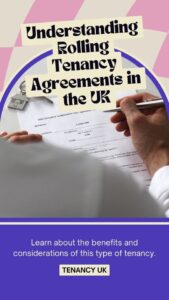Understanding Rolling Tenancies in the UK
What is a Rolling Tenancy Agreement?
A rolling tenancy agreement, also known as a periodic tenancy, is a flexible rental arrangement that continues indefinitely without a fixed end date.

This type of agreement automatically comes into effect when a fixed-term assured shorthold tenancy expires and the tenant remains in the property without signing a new contract.
Rolling tenancies offer both landlords and tenants increased flexibility, as either party can typically end the agreement with proper notice.
For tenants, this usually means giving one month’s notice if rent is paid monthly, while landlords must provide at least two months’ notice.
While rolling tenancies provide freedom to both parties, they may offer less long-term security compared to fixed-term agreements.
Understanding the nuances of rolling tenancies is crucial for both landlords and tenants to navigate the UK rental market effectively
Key Features of Rolling Tenancies
Here are the key features of rolling tenancies (periodic tenancies) in the UK rental market:
No Set End Date: Rolling tenancies continue from month to month or week to week without a fixed end date.

Flexibility in Notice Periods: Tenants typically need to give only one month’s notice when moving out, providing greater flexibility.
Frequent Adjustments: Landlords can adjust rental terms more frequently compared to fixed-term tenancies.
Ease of Regaining Possession: Landlords find it easier to regain possession of the property under rolling tenancies.
Automatic Transition: When a fixed-term tenancy ends without a new agreement, it automatically transitions into a rolling tenancy.
Rent Increases: Rent can be increased during a rolling tenancy, but this must follow specific legal procedures to ensure tenant rights are protected.
Loss of Long-Term Security: Both tenants and landlords lose the long-term security that comes with fixed-term agreements due to the flexible nature of rolling tenancies.
Differences Between Fixed-Term and Rolling Tenancies
Fixed-term and rolling tenancies represent two distinct approaches to rental agreements in the UK housing market.
Fixed-term tenancies offer a predetermined duration, typically 6 or 12 months, providing stability and predictability for both landlords and tenants.
This arrangement guarantees a set rental income for landlords and ensures tenants can stay for the agreed period without unexpected termination.
Conversely, rolling tenancies, also known as periodic tenancies, operate on a month-to-month or week-to-week basis, offering greater flexibility.
With rolling tenancies, either party can end the agreement with
shorter notice periods, usually one month for tenants and two months for landlords.
While fixed-term agreements provide long-term security, rolling tenancies allow for easier adaptation to changing circumstances, making them ideal for those seeking short-term accommodation or landlords preferring more frequent opportunities to review rental terms
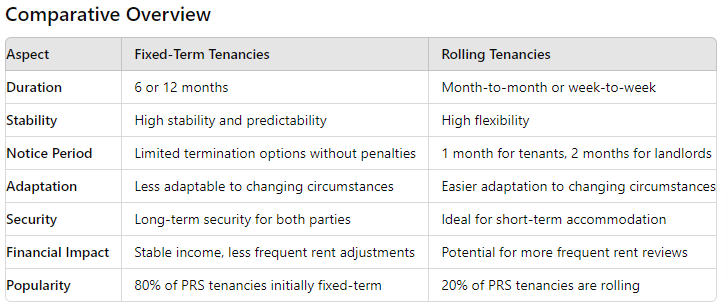
The Legal Framework for Rolling Tenancies
The legal framework for rolling tenancies in the UK is primarily governed by the Housing Act 1988 and subsequent amendments.
These periodic tenancies, which continue on a month-to-month or week-to-week basis, are subject to specific regulations regarding notice periods, rent increases, and termination procedures.
Landlords must provide at least two months’ notice to end a rolling tenancy, while tenants typically need to give one month’s notice.
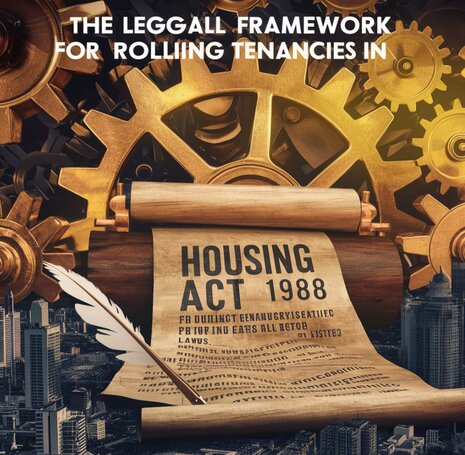
Rent increases are limited to once annually without tenant agreement, and must be implemented using a formal Section 13 notice.
The Renters Reform Bill, currently under consideration, may introduce further changes to this framework, potentially enhancing tenant protections and altering the dynamics of rolling tenancies in the UK rental market.
Key Features of Rolling Tenancies
Month-to-Month or Week-to-Week Basis: Rolling tenancies operate without a fixed end date, continuing on a monthly or weekly basis.
Flexibility for Termination: Either party can terminate the tenancy with proper notice. Tenants typically need to give one month’s notice, while landlords are usually required to give two months’ notice.
Automatic Transition from Fixed-Term Tenancy: Rolling tenancies automatically come into effect when a fixed-term assured shorthold tenancy expires without renewal.
Adjustable Rental Terms: These agreements allow for more frequent adjustments to rental terms, accommodating the dynamic needs of both parties.
Shorter Notice Periods for Relocation: Tenants benefit from the ability to relocate with shorter notice periods.
Reduced Long-Term Security: The flexibility offered by rolling tenancies results in reduced long-term security for both landlords and tenants.
Rent Increases: Rent increases are possible during rolling tenancies. However, landlords must follow specific legal procedures, such as providing proper notice and limiting increases to once annually without tenant agreement.

Rights and Responsibilities of Landlords and Tenants
The rights and responsibilities of landlords and tenants are clearly defined to ensure a harmonious rental relationship.
Landlords must provide at least 24 hours’ notice before entering the property, except in emergencies.
They are responsible for maintaining the property’s structure and exterior, including walls, roofs, and plumbing, and must ensure the property meets health and safety standards.
Tenants, on the other hand, are required to take good care of the property, report necessary repairs promptly, and allow reasonable access for maintenance.
They also have the right to live undisturbed, to know the identity of their landlord, and to be protected from unfair eviction and rent increases.
Understanding these obligations helps both parties navigate their rights and duties effectively, promoting a better renting experience.
The Rise of Flexible Living in the UK Rental Market

Current Trends in the Private Rented Sector (PRS)
The private rented sector (PRS) in the UK is experiencing significant trends in 2024.
Increased demand for rental properties is driven by rising house prices, making homeownership less attainable. Consequently, tenants seek longer tenancies.
Landlords adapt to stricter regulations, including energy efficiency standards and enhanced tenant protections. Build-to-rent developments are rising, offering modern amenities and professional management.

Additionally, technology, such as virtual property tours and online rent payment systems, revolutionizes the rental market.
These trends are reshaping PRS, creating a more dynamic and regulated environment for landlords and tenants alike.
Statistics on Renting in the UK
As of 2022, approximately 35.7% of the UK population are renters, with over 4.4 million households residing in the private rented sector in England alone, representing 19% of all households.
This marks a significant increase from previous decades, reflecting changing lifestyle preferences and economic factors.
The rental market has seen average rents rising to £1,301 per month in England, £736 in Wales, and £957 in Scotland as of May 2024.
Despite these increases, the demand for rental properties continues to outpace supply, contributing to a rental crisis driven by population growth and urbanization.
London remains the most expensive region to rent, with Kensington and Chelsea averaging £3,248 per month.
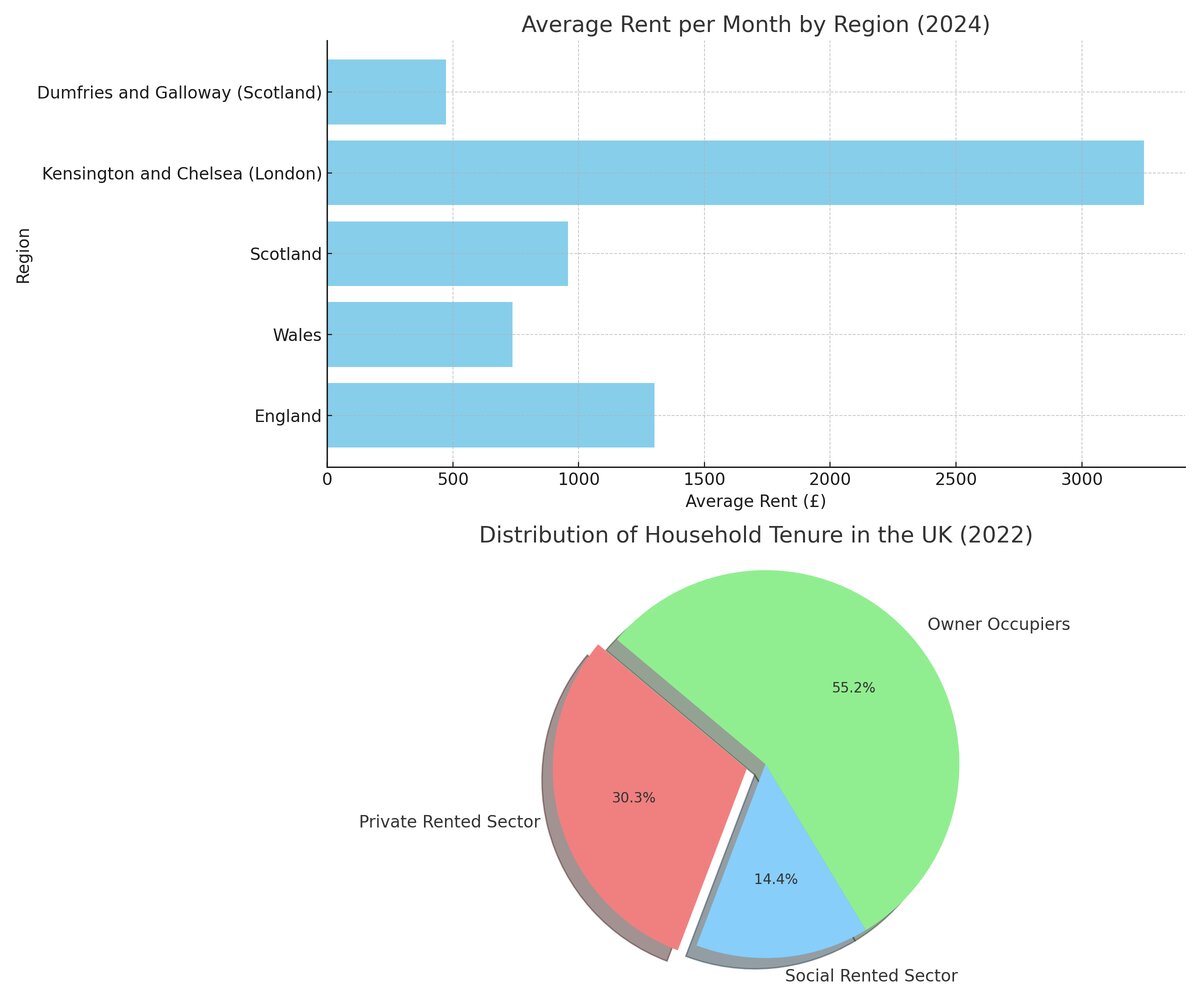
Factors Driving the Popularity of Rolling Tenancies
| Factors | Description |
|---|---|
| Flexibility for Tenants and Landlords | Rolling tenancies allow tenants to give shorter notice periods (typically one month) and landlords to adjust rental terms more frequently and regain possession of the property with short notice. |
| Ease of Transition | Automatically transition from a fixed-term tenancy when it expires, avoiding administrative burdens and potential disputes over new contracts. |
| Dynamic Market Adaptation | Enable landlords and tenants to respond to changes in the rental market more dynamically, allowing for rent adjustments within legal limits and accommodating changing personal or financial situations. |
| Reduced Long-Term Commitment | Appeal to tenants who prefer not to commit to long-term contracts, especially those in temporary situations or planning to buy property soon. |
| Legal Protections and Procedures | Supported by a legal framework in the UK that outlines clear procedures for notice periods, rent increases, and dispute resolution, providing structure and flexibility. |
| Increased Mobility | Suit the rising trend of remote working and changing lifestyle preferences, offering the ability to relocate easily without being tied down by long-term leases. |
| Market Trends and Economic Factors | Attractive in uncertain economic climates, allowing tenants to avoid the financial commitment of a long-term lease and adapt to market fluctuations. |
Benefits of Rolling Tenancies for Tenants
Flexibility in Moving:
Tenants can give shorter notice periods (typically one month) when they wish to move out, providing greater flexibility for personal or professional reasons.
No Long-Term Commitment:
Tenants are not tied down to long-term contracts, making it easier to relocate if needed.
Automatic Transition:
When a fixed-term tenancy ends, it automatically transitions into a rolling tenancy without the need for signing a new contract.
Negotiation Leverage:
Tenants may have more frequent opportunities to renegotiate rental terms, potentially securing better conditions.
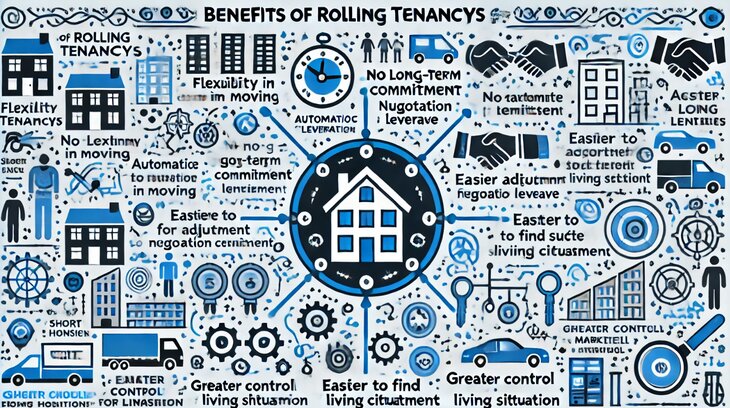
Easier Adjustment to Life Changes:
The flexibility of rolling tenancies makes it easier for tenants to adjust to life changes, such as new jobs, family needs, or educational opportunities.
Potential for Short-Term Rentals:
Rolling tenancies are ideal for tenants looking for short-term accommodation without the need for a fixed-term agreement.
Reduced Financial Commitment:
Tenants can avoid the financial commitment of a long-term lease, which is particularly beneficial in uncertain economic climates.
Easier to Find Suitable Housing:
Tenants can more readily find and move to housing that better suits their needs without waiting for a long lease to end.
Greater Control Over Living Situation:
Tenants have more control over their living situation, with the ability to leave on short notice if the property does not meet their expectations or requirements.
Adaptability to Market Conditions:
Tenants can take advantage of favorable market conditions without being locked into a long-term lease, such as moving to a better property or a more affordable one as opportunities arise.
Increased Flexibility and Mobility
In today’s dynamic rental market, rolling tenancies offer tenants unprecedented flexibility and mobility.
These periodic agreements allow renters to adapt quickly to changing life circumstances without fixed-term contracts.
Tenants typically only need one month’s notice to vacate, enabling them to seize new job opportunities or accommodate family changes easily.
This flexibility is particularly beneficial for young professionals, students, and those in transitional life stages.
Additionally, rolling tenancies can provide security, as tenants are not locked into long-term commitments and can reassess their housing needs more frequently.
While this arrangement may offer less long-term stability than fixed-term leases, it empowers tenants with increased control over their living situations, aligning well with the evolving needs of modern renters in the UK’s bustling property market.
Potential Drawbacks for Tenants
Although rolling tenancies provide tenants with flexibility, they also have potential disadvantages.
The lack of long-term security is a significant concern, as landlords can end the tenancy on relatively short notice, typically two months.
Tenants may find it challenging to plan for the future or feel settled in their homes as a result of this uncertainty.

As a result, landlords may adjust rent rates more frequently in rolling tenancies.
Unexpected moves or changes in rent can also make it difficult for tenants to budget effectively.
A short-term lease may also make it difficult for renters to establish a stable rental history, which may adversely affect their ability to obtain future housing or mortgages.
The flexibility of rolling tenancies must be weighed against the reduced stability and potential for more frequent disruption to tenants’ living arrangements.
Landlord Considerations for Rolling Tenancies
Pros and Cons for Property Owners
It is important for landlords to weigh the pros and cons of rolling tenancies in the UK.
In general, landlords benefit from the ability to adjust rental terms more frequently and the ease of regaining possession of a property with a two-month notice period. In dynamic rental markets where rent prices fluctuate, this can be beneficial.
Since tenants are required to commit for shorter periods of time, rolling tenancies also come with drawbacks. Finding new tenants and maintaining the property can be more expensive with a higher turnover rate.
While rent increases are possible, they must follow specific legal procedures, including proper notice and limitations to once per year.
These factors can help landlords decide whether rolling tenancies are right for their investment goals and property management strategies.
Financial Implications
The financial implications of rolling tenancies for landlords in the UK are significant. These flexible agreements allow for frequent rent adjustments, but can increase tenant turnover and maintenance costs.
The potential for better cash flow is offset by the reduction of long-term income stability, which can impact financial planning in the long run.
Property Management Challenges

Property management challenges pose a challenge to landlords in the UK when renting out rolling tenancies.
Despite their flexibility, these tenancies commonly result in higher tenant turnover, more maintenance, and frequent administrative tasks.
It is essential to balance the benefits of flexibility with the potential for elevated operational demands through effective management.
Rent Increases in Rolling Tenancy Agreements
In order to increase rent under rolling tenancy agreements in the UK, specific legal procedures must be followed.
It is possible for landlords to increase rent, but they must provide proper notice and can only do so once annually without a tenant agreement.
Rents can therefore be adjusted according to market conditions, protecting tenants’ rights while balancing both parties’ interests.
Legal Requirements for Rent Reviews
| Legal Requirement | Description |
|---|---|
| Written Notice | Landlords must provide written notice of any rent increase, typically at least one month in advance for rolling or periodic tenancies and six months for yearly tenancies. |
| Market Rate Alignment | The rent increase must be in line with the market rate and cannot be arbitrary. |
| Assured Shorthold Tenancies | For assured shorthold tenancies, landlords can use a rent review clause or the Section 13 procedure to propose an increase. |
| Tenant Appeal Rights | If a tenant disagrees with the proposed increase, they have the right to appeal to a Rent Assessment Committee. |
| Rent Assessment Committee | The Rent Assessment Committee will determine a fair rent based on market conditions if there is a dispute. |
| Balanced Rental Market | These legal requirements help maintain a balanced rental market and protect tenants from unfair rent hikes while allowing landlords to adjust rents reasonably. |
Best Practices for Fair Rent Increases
Implementing fair rent increases in the UK requires a thoughtful approach that respects both landlord and tenant rights. Landlords should adhere to legal requirements, providing proper notice (typically one month for periodic tenancies) and limiting increases to once annually without tenant agreement.
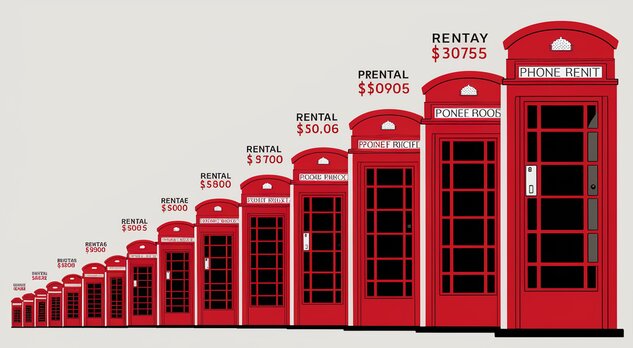
It’s advisable to research local market rates to ensure proposed increases are reasonable and justifiable.
Open communication with tenants is crucial; explaining the reasons for the increase can foster understanding and maintain positive relationships.
Gradual, smaller increases are often more palatable than infrequent, larger hikes. For fixed-term tenancies, rent reviews should be clearly outlined in the original agreement.
Landlords must use the appropriate Section 13 notice for periodic tenancies, giving tenants the opportunity to challenge unfair increases through the First-tier Tribunal.
By following these best practices, landlords can maintain profitability while ensuring tenants are treated fairly and transparently.
Rolling tenancies: How to navigate the end
Notice Periods and Procedures
The end of rolling tenancies in the UK requires an understanding of notice periods and procedures.
Tenants are typically required to provide one month’s written notice, while landlords must provide two months’ notice under Section 21 of the Housing Act 1988.
To avoid disputes, the termination notice must be clear, state the termination date, and comply with legal guidelines.
All terms of the original tenancy agreement must be met, including property maintenance and outstanding payments.
Following these procedures will ensure a smooth and legally compliant end to the tenancy, resulting in a positive rental experience for both tenants and landlords.
Landlords vs. Tenants: UK Notice Periods and Procedures
| Aspect | Notice Periods and Procedures for Tenants in the UK | Notice Periods and Procedures for Landlords in the UK |
|---|---|---|
| Standard Notice Period | Minimum of one month's written notice, coinciding with the rental payment date. | Minimum of two months' written notice using a Section 21 notice under the Housing Act 1988. |
| Fixed-Term Tenancies | Can only end early if a break clause exists or by negotiating with the landlord. | For breaches of the tenancy agreement, use a Section 8 notice with a notice period varying from 2 weeks to 2 months. |
| Written Notice | Notice must be in writing and clearly state the intended move-out date. | Notices must be in writing, clearly stating the date when the tenant must vacate the property. |
| Break Clause | Can terminate the tenancy early if a break clause is included, usually with two months' notice. | Not applicable; landlords use Section 21 or Section 8 notices. |
| Email Notice | Some landlords accept email notices; verify if acceptable per tenancy agreement. | Must use the correct legal form for the notice and ensure compliance with legal requirements. |
| Repairs and Maintenance | Ensure all repairs are reported and the property is left in good condition. | Ensure the tenant’s deposit is protected in a government-approved scheme before serving a notice. |
| Final Rent Payment | Ensure all rent payments are up to date, including the final month's rent. | Ensure all legal obligations (EPC, gas safety certificate, “How to Rent” guide) are met before issuing a notice. |
| Inventory Check | Conduct an inventory check to agree on the property's condition. | If the tenant does not vacate by the specified date, apply to the court for a possession order. |
| Utilities and Services | Notify utility providers of move-out date and settle any outstanding bills. | Maintain open communication with tenants throughout the notice period. |
| Forwarding Address | Provide a forwarding address to the landlord for future correspondence. | Not applicable. |
Dispute Resolution in Rolling Tenancies

Dispute Resolution in Rolling Tenancies in the UK
1. Open Communication: Encourage dialogue between tenants and landlords to resolve issues amicably.
2. Mediation Services: Utilize mediation services to facilitate discussions and find mutual agreements.
3. Tenancy Deposit Scheme (TDS): In disputes over deposits, refer to the TDS for adjudication.
4. Citizens Advice: Seek guidance from Citizens Advice for legal advice and support.
5. Court Action: As a last resort, disputes can be taken to court for a formal resolution.
Common Issues and How to Address Them
There are several key strategies involved in effective dispute resolution in rolling tenancies in the UK.
For rent arrears, it’s crucial to communicate early, offer payment plans, and seek advice from Citizens Advice.
Property maintenance issues can be prevented by regular inspections and prompt repairs.
The Tenancy Deposit Scheme (TDS) can be used to resolve disputes over deposits fairly.
Establishing clear house rules and mediating discussions are essential to resolving noise complaints.
All communications should be documented to ensure accountability and clarity for lease violations.
The Future of Rolling Tenancies in the UK
Potential Impact of the Renters' Reform Bill
As part of the Renters’ Reform Bill, the UK aims to abolish Section 21 “no-fault” evictions, enhance tenant security, and introduce lifetime deposits.
These changes are expected to create a fairer system, reduce arbitrary evictions, and improve tenant mobility.
It is likely that landlords will need to adapt to stricter regulations, which may affect property management practices and tenant relationships, fostering a more balanced rental market.
Key Proposed Changes
The Renters’ Reform Bill in the UK proposes a number of key changes, including the abolition of Section 21 “no-fault” evictions and the introduction of lifetime deposits.

As a result of these measures, tenants will be more secure, rental practices will be more fair, and moving will be simplified.
A more balanced and equitable rental market will be promoted by stricter regulations for landlords.
How It May Affect Rolling Tenancies
Rolling tenancies may be significantly affected by the proposed changes to the Renters’ Reform Bill in the UK, as it would eliminate “no-fault” evictions under Section 21.
In this way, landlords will have a harder time terminating rolling tenancies without valid reasons, promoting stability for tenants.
Lifetime deposits will also simplify tenant transitions between properties, potentially increasing tenant mobility while ensuring compliance with stricter property standards.
Emerging Trends in Flexible Living
There is a shift towards co-living spaces, short-term rentals, and adaptable housing solutions in flexible living in the UK.

As remote work and lifestyle preferences change, these options offer affordability, convenience, and community.
As opposed to short-term rentals, co-living communities provide shared amenities and social opportunities. A diverse range of tenants seeking modern, adaptable housing solutions can take advantage of this evolving landscape that meets their demand for more dynamic, flexible living arrangements.
Technology and Smart Homes in Rental Properties
The rental market in the UK is being revolutionized by technology and smart homes.
To enhance tenant convenience and property appeal, landlords are increasingly integrating smart devices like thermostats, security systems, and energy-efficient appliances.
Besides improving living conditions, these innovations also attract tech-savvy renters seeking modern amenities.
In addition to increasing tenant satisfaction, smart home technology promotes energy efficiency, aligning with contemporary living standards and sustainability goals.
Co-living and Other Alternative Housing Models
Co-living and other alternative housing models in the UK are gaining popularity due to their affordability, community-oriented layouts, and innovative designs.

The co-living concept is attractive to young professionals and remote workers because it offers shared amenities and social opportunities.
Eco-friendly housing with green roofs and solar panels promotes sustainability, while tiny homes and modular housing units are cost-effective, flexible living options.
These models cater to diverse needs, fostering a more dynamic and inclusive housing market.
Q&A
A rolling tenancy agreement, also known as a periodic tenancy, continues on a monthly or weekly basis after the fixed-term tenancy ends without the need for a new contract. It provides flexibility for both tenants and landlords.
A rolling tenancy begins automatically when the fixed-term tenancy expires and neither the landlord nor the tenant has signed a new fixed-term agreement.
Tenants must provide at least one month’s written notice, which typically must coincide with the rental payment date.
Landlords must provide at least two months’ notice using a Section 21 notice to regain possession of the property without a specific reason.
Yes, landlords can increase the rent during a rolling tenancy, but they must follow specific legal procedures, including providing proper notice and limiting increases to once annually without tenant agreement.
Rolling tenancies offer flexibility, allowing tenants to move out with short notice. This is ideal for those with uncertain or changing circumstances.
The main disadvantage for landlords is the lack of long-term financial security due to the shorter commitment from tenants, which can lead to higher tenant turnover and increased maintenance costs.
Both the landlord and tenant need to agree on the terms and sign a new fixed-term tenancy agreement to formalize it.
If a tenant leaves without giving the required notice, they may be liable for rent until the notice period is properly served or until a new tenant is found.
Yes, rolling tenancies are covered by the same legal protections as fixed-term tenancies, including deposit protection and the landlord’s duty to maintain the property.
Conclusion: Embracing Flexibility in the UK Rental Market
Flexible rental markets in the UK are essential for meeting tenants’ and landlords’ needs.
Alternative housing models like co-living spaces, tiny homes, and modular units offer innovative, sustainable solutions that cater to modern lifestyles.
As the market shifts towards more adaptable living arrangements, both parties can benefit from enhanced convenience and affordability.
Find out more about these flexible housing options today to stay ahead of the dynamic rental market.
Feel free to contact us if you would like to learn more and find the perfect housing solution for you.
Sign Up for Free Today & Get 40% Off Lendlord Premium Plan!

